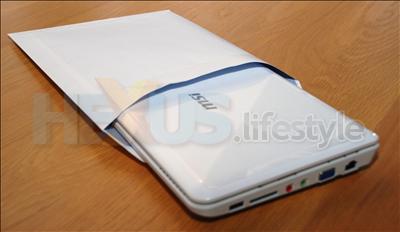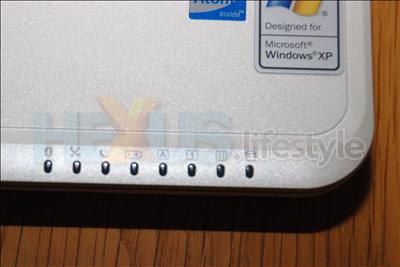Design and usability
In terms of aesthetics, MSI's done a grand job. The Wind looks the part; it really is a stylish little device. The glossy-white shell takes a page out of the Eee's book - which in turn took entire chapters out of Apple's iPod book - and results in a device that's something of a fashion accessory.
You could just picture various Wind users strutting their subnotebooks at the local Starbucks, and if you're wanting to rub the £330 price-tag into the face of your iPhone-wielding friends, you'll be happy to hear that yes, Wind will fit easily into an A4-sized envelope.
The Wind, combined with its three-cell battery, weighs a very reasonable 1kg. Users who've become accustomed to lugging around a full-size laptop will immediately be thanking the heavens.
Its size, measured at 260mm x 180mm x 19-32mm, makes the device larger than most subnotebooks, but by no means too big. The Wind is still very small, and its dimensions are emphasised when compared to a Dell Inspiron 1520.
Its useful size and weight are just the starters, however. Open the device up and you're presented by its two (literally) big selling points: the 10in LED screen, and the "big-size" keyboard.
We've mentioned that we're not particularly fond of the screen's 1,024 x 600 resolution. However, we should add that we're impressed with its crisp image, the brightness levels and horizontal viewing angle. Throw in a higher resolution and it'd be almost perfect.
The keyboard, too, is almost perfect - almost. MSI describes it as "big-size", and though it's by no means big, it's larger than you'll have seen on earlier subnotebooks. For touch-typists it's a pleasure to use. The keys are well-sized, and there's even a small gap between them.
With the Wind's larger-than-usual proportions, the keyboard becomes comfortable to use - an accolade rarely associated with such small devices. Still, let's not start kissing MSI's designers just yet. There's one slight problem, the keyboards "Fn" key is placed in the bottom left-hand corner, where you'd normally expect to find "Ctrl". It isn't a deal-breaker, but users of Ctrl-based shortcuts will find it takes some getting used to.
Though the keyboard is "big-size", the touch pad simply isn't. The touch surface itself is adequate, but its mouse buttons are too small for our liking, and not clearly defined. We often find ourselves looking down to locate it. To the touch pad's credit, however, is the built-in scrolling support. With MSI's drivers installed, gesture-based scrolling is available and much-needed, too.
Moving on from the almost-perfect keyboard, there are also plenty of useful additions and connectivity options, starting with a 1.3 megapixel camera and microphone built-in above the 10in screen.
On its sides you'll find all your usual ports. There are three of the USB variety, two found on the left side and one on the right. The left side also houses the power socket, vent holes and Kensington lock. On the right, alongside the USB port, you'll get a card reader, audio ports, VGA out and Ethernet connector. Nothing out of the ordinary, but everything you'd expect.
The Wind's inside-front edge houses eight tiny LEDs to illustrate items such as power, hard-disk activity and wireless. Don't worry, closing the lid won't hide them away - you'll still see them, just.
Flip the Wind over and you'll see the three-cell battery up top, and those two little circles on the front-corner edges are the built-in stereo speakers. The sound output is, as you'd expect, adequate for its purpose.
Hats off to MSI in terms of design, the Wind looks the part and everything is where you'd expect to find it. Now, this wouldn't be a HEXUS review without a few numbers, would it? Let's take a look at a few simple benchmarks and talk all things performance.



















